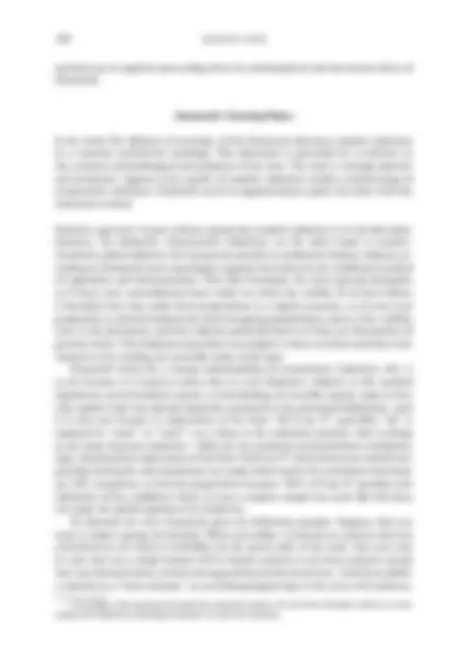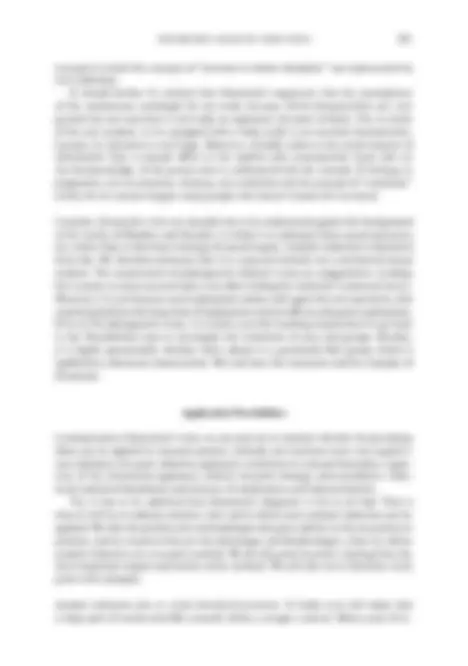
















Study with the several resources on Docsity

Earn points by helping other students or get them with a premium plan


Prepare for your exams
Study with the several resources on Docsity

Earn points to download
Earn points by helping other students or get them with a premium plan
Community
Ask the community for help and clear up your study doubts
Discover the best universities in your country according to Docsity users
Free resources
Download our free guides on studying techniques, anxiety management strategies, and thesis advice from Docsity tutors
The research method of analytic induction, which is used in social science research, particularly in qualitative research. The method involves examining research units one by one and adjusting theoretical insights to each observation until theoretical saturation is achieved. the starting points of analytic induction, its advantages and disadvantages, and its application possibilities.
Typology: Study notes
1 / 22

This page cannot be seen from the preview
Don't miss anything!















JACQUES TACQ Catholic University of Brussels
Abstract: The Polish sociologist and philosopher Florian Znaniecki, well-known by his research together with W. I. Thomas on Polish immigrants in the United States, explicated the principles of his “analytic induction” in a later publication The Method of Sociology. This is a method in which research units are examined one by one and in which theoretical insights are adjusted to each observation. This process of continuous re-formulation of the research hypotheses completes when new observations do no longer offer new insights, i.e., when theoretical saturation takes place. In this paper a treatment of the original view of Znaniecki is offered. His starting-points—inductive approach, respect for the facts, dynamical fundamental attitude, special treatment of exceptions, attention for validity and intensional approach—are explained, as well as his formulation of analytic induction in four steps and the principle of structural dependence and the principle of causality. Starting from this original view, the advantages and disadvantages of analytic induction are balanced against each other and this method is examined with the aim of application. Critiques of the approach in the period around 1950, by Robinson, Lindesmith and Cressey and, later in time, by Peter Manning, are discussed and additional research examples from Belgium and the Netherlands serve as illustration of the arguments.
Keywords: analytic induction, social science research, research methodology, qualitative research, Florian Znaniecki, Polish sociology
Introduction
The opposition between qualitative and quantitative methodology in social-scientific research is an old sore which still is—and most certainly will remain—the subject of much discussion. Indeed, we are flooded with a wave of writings on the relationship between quantitative and qualitative research in the social sciences and on causality during the last decades. The majority of the texts deal with (causality in) qualitative research, mostly in a controversy with quantitative research. Especially in the world of political scientists discussing international comparative research we see an enormous amount of publications on “qualitative comparative analysis,” “comparative case- studies,” “causal inference,” “counterfactual analysis,” “process tracing,” “research designs in qualitative analysis,” “moving beyond qualitative and quantitative strate- gies” and many other writings. A book often quoted is the one of King, Keohane and
Jacques Tacq is Professor of Sociology at the Catholique University of Brussels, Belgium. He is also Visiting Professor in the Summer School in Social Science Data Analysis and Collection at University of Essex. His publications in methodology of social science include books: Multivariate Analysis Tech- niques in Social Science Research: From Problem to Analysis (1996); Het methodologisch atelier: adviezen en beschouwingen voor de sociale wetenschappen (2001); e-mail: jacques.tacq@kubrussel.ac.be
Verba (1994), entitled Designing Social Inquiry. Charles Ragin, too, with his book The Comparative Method and Collier with his writings on Selection Bias show high scores on the citation-index of political sciences. Moreover, the pleas for Mixed Methods in the social sciences—of Teddlie and Tashakkori, Creswell and others—contain discus- sions on causal explanation and inference within a frame of integration of qualitative and quantitative research. Big words are being used. Just like within the recent more general context of revival of qualitative research designs, expressions are being used such as “The Interpretive Turn” and “The Fifth Moment” (see among others Denzin 1994), Tashakkori and Teddlie (2003) speak of “The Third Methodological Movement” within the context of mixed methods research. In all these debates there is implicitly an important reference to Max Weber, who already built a bridge between the quantitative and qualitative approach in social science in the nineteenth century. For, positivism a la Comte and Mill is too one-sided. _Hermeneutics_a la Dilthey, Windelband and Rickert has also its one-sidednesses. And sociologist Max Weber succeeded in bringing together the “Ver- stehen” (Understanding) of hermeneutics and “Erkla¨ren” (Explanation) of positivism into a combined procedure, which he called “Erkla¨rendes Verstehen” (Explanatory Understanding). But, alas, the reference to this historico-philosophical background made by contemporary authors is only implicit. Collier, Teddlie, Ragin and the afore- mentioned authors King, Keohane, Verba of the book Designing Social Inquiry , all make abundantly use of causal terminology, but the words used do not cover the con- tents of the actual debates. The topics discussed are randomization, independence of observations, statistical generalization, specification error, measurement level, sam- ple size and other statistical subjects, also a discussion of thick and thin analysis, but the discussion would benefit from a more fundamental approach and from a stronger link with the philosophical background. We admit, though, that the discussion of the opposition between qualitative and quantitative research is predominantly methodological in nature. Some examples of such methodological distinctions are: exact measurement and generalization as opposed to being close to the data and being in line with the unique character of reality and its complexity (compare with the distinction between variable-oriented and case-oriented approach of Charles Ragin); also an opposition between deductive and inductive approach, between statistical testing and exploratory research, between “testing” and “gauging,” between objective and subjective approach; looking for sci- entific laws which hold for all times and contexts as opposed to looking for insight in the “here and now context,” which is time-related and where the context is essential for the insight; further also the well-known distinctions such as emphasis on relia- bility versus emphasis on validity; correspondence between theoretical concept and operational variable on the one hand and correspondence between reality and under- standing of reality on the other hand; “la cuisine scientifique” (the scientific kitchen) versus the gateway to science; context of justification versus context of discovery; and in relation to the operating procedure: statistical analysis with big samples and enqueˆtes as opposed to in-depth interviews and participant observation; aim at a dis- tance between investigator and investigated as opposed to aim at closeness between
method can be applied, proceeding from the philosophical and theoretical ideas of Znaniecki.
Znaniecki’s Starting-Points
In his book The Method of Sociology (1934) Znaniecki discusses analytic induction as a research method for sociology. This discussion is preceded by a criticism on the common methodological prescriptions of his time. The style is strongly polemic and rethorical. Against every quality of analytic induction stands a shortcoming of enumerative induction. Znaniecki seems to approximately equate the latter with the statistical method.
Inductive approach. It goes without saying that analytic induction is in the first place inductive , not deductive. Enumerative induction, on the other hand, is counter- intuitively called inductive, for it proceeds actually in a deductive fashion. Indeed, ac- cording to Znaniecki most sociologists organize their ideas by the traditional method of exposition and demonstration. They first formulate the most general principles as if these were unconditional basic truths on which the validity of all that follows is founded; then they order their propositions in a logical sequence, as if every next proposition is derived deductively from foregoing propositions and as if the validity owes to the derivation; and they indicate particular facts as if they are illustrations of general truths. This deductive procedure was taught to them at school and they were trained in it by reading the scientific works of the past. Znaniecki warns for a wrong understanding of enumerative induction. For, it is not because it is based on facts that it is less deductive. Indeed, in this method hypotheses are formulated a priori, so that findings of scientific inquiry make at best only explicit what was already implicitly contained in the postulated definitions. And it is also not because in expressions of the form “All S are P” quantifier “all” is replaced by “some” or “most”—as is done in the statistical method—that in doing so the latter becomes inductive. 1 After all, the statistical method follows a deductive logic. Starting from expressions of the form “All S are P” observations are carried out, possibly thousands, and calculations are made which lead to the conclusion that there are 20% exceptions, so that the proposition becomes “80% of S are P,” possibly with indication of the confidence limits, in case a random sample was used. But this does not make the global argument less deductive. To illustrate his view, Znaniecki gives the following example. Suppose that you want to study a group of criminals. When you define a criminal as a person who has committed an act which is forbidden by the penal code of the state, then you may be sure that not a single feature will be found common to all those persons except that very formal feature of their having performed that kind of act. And if you define a criminal as a “born criminal,” as an anthropological type in the sense of Lombroso,
(^1) According to this argument the inductive-statistical scheme of Carl Gustav Hempel, which is a weak- ening of his deductive-nomological scheme, is in fact not inductive.
and include in your study only those who represent this type, you will find a number of features or combinations of features common to and distinctive of “criminals” in this sense, but these will be features implied in and resulting from Lombroso’s anthropological structure. In a word, you can find nothing in the definition of a class that you have not already put into it.
Respect for the facts. In Znaniecki’s view, it can also be deduced from the foregoing that the traditional method suffers still from another defect, i.e., from a distressing lack of respect for the facts. For the inductively oriented sociologist, the empirical data are the ultimate basis. For, unlike the statistically oriented methodologist, for whom the factual material has solely illustrative value, he considers every empirical datum as an intellectual challenge. Whereas statistical method chooses the line of the least resistance, the inductive researcher chooses rather the difficult path. Each new fact that could contradict his original insights, is for him a revolt against reason and forces him to adjust and revise his theory.
Dynamical fundamental attitude. It appears that Znaniecki lays strong emphasis on the dynamics of the scientific enterprise. He draws his attention predominantly on the way in which insights are obtained, rather than the way in which insights are presented, justified or defended. He refers to what the French call “la cuisine scientifique” (the scientific kitchen) and which means the preparatory phase of scientific work, the phase of marking off the research problem, of depicting the sociological angle and filling the gaps by means of conjectures. The sociologist should work more in the kitchen and sit less at the table, so seems to sound the keynote of Znaniecki’s work. He makes a plea for a dynamical fundamental attitude. The inductive scientist does not consider truth as a final and unshakable result of research past and done with, to be contemplated with Platonic enjoyment. On the contrary, he is always keen on gaining new insights. He is never satisfied, always asks the question of the new.
Special treatment of exceptions. The dynamic ideal of knowledge acquisition is very well shown in the treatment of exceptions. The concern is not the exception as such, but rather our attitude towards exceptions. In the statistical method this attitude is clearly mistaken. For, exceptions are considered as “outliers.” To understand what is meant here, we should only think of a scatterplot, in which certain points do not belong to the model. In such a case there are two possibilities. Either the number of exceptions is very small, e.g., 5% of the total of examined cases. Then the statistician will accept the postulated statistical law in a weakened form. The expression “All S are P” is replaced by “95% of S are P.” Or the number of exceptions is too big. The postulated law does not pass the test of significance and is, consequently, rejected. 2 Znaniecki argues that in both cases exceptions are put aside as uninteresting. They remain unanalyzed. The power of analytic induction as a research method is exactly
(^2) Who is acquainted with statistics will know that the statistical law is not really rejected. For, that would mean that the null hypothesis is accepted, i.e., that the accused is acquitted in the absence of proof. But this does not affect Znaniecki’s argument.
used, the class A to which it applies has been already circumscribed, i.e., that any datum is already either A or non-A. But the approach in fact has to run the other way round. For, it is obvious that from a scientific point of view logical extension depends entirely on logical compre- hension. Any object belongs to the class A only if it possesses all these fundamental characters which are comprehended in the concept A. Consequently, the assumption that a certain word is applicable to all the objects or processes of a class, is only justified if we know already all the characteristics of this class and are using this word to symbolize this knowledge. In other words, we should be prepared to consider our concepts as tentative and provisional all the way. And if, after thorough examination, it appears that our concepts are not a good representation of the classes we intended to indicate, then we have to redefine our concepts.
Znaniecki’s Analytic Induction
First abstraction, thereafter generalization. The confrontation with enumerative induc- tion continues to dominate the whole oeuvre of Znaniecki. It is bugging him that the statistician first generalizes. For, the statistician studies a great number of cases and looks for characteristics that are common. And he thinks that these features can be abstracted in the conceptual sense because of their generality. But in fact the process has to run the other way round. Enumerative induction abstracts by generalizing. Analytic induction on the other hand generalizes by abstracting. Starting from concrete cases, those characteristics are abstracted that are essential and only thereafter one generalizes, presuming that in so far as essential, they must be similar in many cases. So, there is another order of operating procedure. That is why Znaniecki writes that enumerative induction begins where analytic induction ends. So, having a sociological research process in mind, analytic induction has to be situated predominantly in the beginning phase, as a method which, making use of small numbers of cases, acquires thorough insight and develops theory.
Essential characteristics. The foregoing remains vague if it is not explained what is meant by “thorough insight.” When is one theory better, more profound, richer than the other? What does it mean that we have extracted the essential from concrete cases? Znaniecki elaborates extensively on this question and he also gives examples. By making classifications we get an idea of the distinction between essential and non-essential characteristics. Suppose we have two classifications of animals, one by color, the other by anatomic structure, then the former is less essential than the latter. This is because the classification of animals as colored things leaves more room for many other classifications, whereas the classification by anatomical structure tends to eliminate all other classifications. We may classify animals by their sizes, by their shapes, by their voices and by their movements; and none of these classifications will bear any reference to the color classification. On the other hand, a theory in terms of anatomical structure will be capable of explaining similarities and differences in
color, size, shape and movements, because the anatomical structure is correlated with physiological functioning of organisms. We see that, according to Znaniecki, it all comes down to constructing a hierarchy of characteristics in terms of gradation of importance, i.e., in terms of the extent to which they are shared by many classes. For example, the possession of vertebrae is a characteristic which determines the nature of the horse in a larger measure than the formation of his feet, because the first characteristic is shared by the species horse with all the species of mammals, birds, reptiles and fish, the second only with a relatively small variety of hoof-bearing animals. Here, Znaniecki reacts against sociologists who have the inclination to classify social systems by means of subjective factors such as instincts, wishes, desires, emotions, attitudes and sentiments. In his view social systems have to be studied in terms of their real, not their ideal components. Znaniecki goes on warning that there is a difference in method between enu- merative and analytic induction. That which is more general, i.e., which is shared by a larger set of cases, is not necessarily more important. For, trivial characteristics such as to be equipped with a body, are very general but not essential. Consequently, it is not surprising that there exist so many sociological schools which live separately in peaceful coexistence. For, every school is funded on other generalizable characteris- tics of social life and therefore builds another theory. Such mutual tolerance would be impossible if sociologists would use the principle of importance as the guideline of their research.
Analytic induction in four steps. It appears that the order of procedure—first abstrac- tion and then generalization and not vice versa—is crucial for Znaniecki. This brings him to the formulation of analytic induction in four steps :
The principle of structural dependence. The principle of structural dependence is re- lated to the establishment of a hierarchy of characteristics in terms of gradation of importance. Two artifices to make such an hierarchy are a. To think away an element and look whether there is a susbstantial change; b. The use of comparative method.
way a trade union representative does not act as a private person, but as the delegate of a pre-existent social organisation. And in a comparable way there is a difference between the man in the position of president of a golf club as a private person and the man who takes the leadership as a professional golfer in this club. In other words, there is a difference between an executive person who derives his authority from the members of the group, and the person who derives his authority from an established institution.
Phylogenetic analysis. We should, however, not be satisfied with just an ontogenetic approach, because an explanation in terms of the most essential elements remains a static analysis. We must look at the social evolution and, therefore, when giving an explanation of a social system, we should have the courage of going back in time. For, just as a long time ago there were no horses, potato bugs, pine-trees or roses, so there was a time when no actions of technical cooperation or written communication, no kings, merchants or university professors, no states, churches, army regiments or economic corporations existed anywhere. Going back in time in order to investigate the original state of a system, is called phylogenetic analysis by Znaniecki. Going back to the example, in which it is stated that the establishment of ruling au- thority is dependent on collective will, Znaniecki distinguishes three religious groups, one with the individual rulership of a priest, another with the rule of a committee of elders and a third with non-authoritative but recognized leadership of a prophet. All three kinds of leadership are structurally dependent on collective will, but there are elements of difference. A group subjected to individual rule throws upon its ruler all responsibility for its public actions, but also tends to control every step he makes. A group ruled by a committee does less controlling, but also puts less responsibility on the committee. A group with institutional leadership of a priest gives the leader the least responsibility and control. In a phylogenetic analysis we presume that once there must have been religious groups with a collective will, but without the leadership of an individual, a committee or an institution. This actually proves to be the case for tribes in Indonesia, which are investigated by ethnologists. These are even groups with a stable structure, regular gatherings and a clear distinction between public and private activities.
The principle of causality. In Znaniecki’s view the principle of structural dependence, even in the phylogenetic sense, is not the same as the principle of causality. An analysis of the structural dependencies, even when taking time into account, still proceeds in a static fashion. A causal analysis, on the other hand, is dynamic in nature. The rela- tions between causes and effects do not have the character of internal, but of external influences, which affect systems. They bear upon processes, in which definite an- tecedents bring about definite consequents and in which a system undergoes changes. Meeting an enemy by accident is not a causal stimulus when certain tendencies, such as to avoid the enemy, to fight him or to start an action of reconciliation, were latently present. For, the stimulus does not bring about a change into the structure of the system. The influence of this meeting is a derivative of the system as it already existed
in the axiological sense. In such cases, the action—avoid, fight, reconcile—is executed in a spontaneous way. Here then, only the principle of spontaneity plays a role. Two requirements must be kept in mind when analysing facts of causation in the social world. First, nothing happening within a social system calls for causal explanation which does not constitute a change of the system as a whole. Secondly, nothing can change the system as a whole which does not irremediably conflict with the original significance of its values, hence, there has to be a conflict with the prevailing values in the axiological sense. Counter-examples of the first requirement are a quarrel between the members of a group or the disobedience of a child towards its parents. There is no causality here, as for each of these actions they are either originally implied in the very structure and composition of the system or there exists a counter-action, which avoids the consequences for the system as a whole. There is also no causality in the case of latent tendencies, because then the second requirement is not fulfilled. For example, a parent may wish to give his child certain educational advantages, but is unable to afford it, because he is too poor. Or suppose that certain groups in society cannot function in a normal way because of political repression. Obstacles of this kind are only technical obstacles, which hinder the actual realization of a system, but do not affect the structure of the system. The latter occurs only when there are axiological obstacles, i.e., when the essential values of the system are conflicting. This is for instance the case when immigrant children come into contact with children of the community and start despising the cultural standards of their parents-immigrants and accept instead the standards of the new milieu.
Criticism
Before going into the application possibilities of analytic induction, we first give some points of criticism. First of all, there has been a critique of the approach in the period around 1950, by Robinson (1951), Lindesmith (1947) and Cressey (1953). Later in time, a rather extensive criticism has been given by Peter Manning in his essay “Ana- lytic Induction” (Manning 1982; see also Vidich and Lyman 2000). We would like to advise this essay of Peter Manning to the reader, because it is a well-balanced eval- uation, in which the advantages and disadvantages of analytic induction are weighed against each other and in which many examples are given, also of Manning’s own research on successful abortion seekers on a college campus. According to Man- ning advantages are—next to general advantages of qualitative analysis—the capacity to generate theory, the capacity to revise theories through the careful analysis of deviant cases or negative evidence, the capacity to integrate sampling models and the potential for creating processual theories. Disadvantages are—we summarize— its failure to predict, its inability to deal with matters of degree or variation when searching for universal statements, its inefficiency because of procedural variations and its failure to produce true causal analysis. In what follows our argumentation will be—like Manning’s approach—also a weighing up of pros and cons, but will be more a discussion with Znaniecki’s text on analytic induction in his book “The method of
And even when no open questions are provided for, even then a researcher does not start from closed definitions (de-finitum = this is the end), but from tentative characterisations. It happens all too often that these characterisations have to be adjusted or revised. Suppose, for example, that in an investigation of birth control a distinction was made between wanted and unwanted births, then it will soon become apparent that a great number of respondents do not fit into this strict dichotomy, so that a third category of “tolerated births” will have to be added in-between the two categories.
Exceptions. It is true, a statistically oriented methodologist using a sample of thousand cases does not perform thousand separate case-studies. And it is also true that he does not perform each of the thousand random draws separately in order to each time adjust his view. But he does not just put the exceptions aside as uninteresting, at least not when they show a minimum of frequency. When he cannot reject the null hypothesis, he will say that the result is undecided and open to further inquiry. He will then possibly consider to make the research population more homogeneous or even to re-formulate the research problem. Znaniecki looks exclusively to micro-situations in which separate examination of “cases” sharpens our concept formation. But the investigation of big numbers can sometimes be a target in itself. If, for instance, in an investigation of medical consumption with a sample of 2000 patients, one comes to the constatation that the average usage of medicaments is extremely high, then this can be surprising for the researcher and alarming for policy-makers. In other words, frequencies sometimes have a value in itself and can also bring about an increase of knowledge. The foregoing argument holds not only for frequencies , but for relations as well. For instance, in a similar investigation of medical consumption one comes to the constatation that there is a strong statistical association between health complaints and the consultation of a doctor or a medical institution. Among patients with com- plaints, 75% go for consultation, whereas among patients without complaints only 7%. We learn from this that preventive behaviour is almost absent in the investigated population. And this knowledge can only be acquired by analysing a big random sample, not by casewise performing thorough thinking about a new “fit” with real- ity. And besides, the statistically oriented methodologist can also use his methods and techniques for the sake of concept formation. To that end he uses techniques of latent structure analysis, such as factor analysis, cluster analysis and multidimensional scaling techniques. For example, in an investigation of the ideological attitude of the scientific personnel at a university a cluster analysis was performed and a very surprising cluster appeared, of professors from the beta faculties who showed the inclination to support the leftist student movement. We are not dealing here with one seldom exemplar, but with a statistically significant cluster of persons, and yet it is most certainly an interesting finding, which draws the attention. Moreover, another kind of knowledge is concerned here, which is reliable, because it is based on large numbers and has stood the statistical test.
Intension. Znaniecki does not indicate what has to be understood by the meaning (intension, comprehension) of a concept. In fact he only deals with extension, i.e., the set of units which applies to a concept, in other words the valid class of reference. And in his view a concept is more important when the extension is larger. Moreover, it is difficult to speak of an intensional and extensional approach, for, every concept has an intension (content, meaning, comprehension) as well as an extension (size, area of application). The concept of unemployment means “that one is not or no longer employed” (intension) and is applicable to, say, 10 percent of the labour population (extension). Znaniecki rightly points to the fact that a discussion of the intension of a concept is most important and that a change of intension will have consequences for the extension, possibly even for the reference. For, the richer a concept, the fewer cases it covers, in other words: the larger the intension, the smaller the extension. To take Znaniecki’s example, the extension of the concept of “hoofed animal” (hoofed vertebrate) is smaller than and is contained in the extension of the concept of “vertebrate.” The reverse does not hold: it is not because a concept covers less cases that it is richer. Another example, which will be more engaging for the social scientist, is the criticism on the calculations of the percentage of unemployed by means of government statistics, say in Belgium. By means of a wrong concept of “being unemployed,” a great number of unemployed people were embezzled. The intension of the concept “unemployed” is at stake here and the extension was determined by it. We admit that Znaniecki is also right in his treatment of abstraction and general- ization. For, the classically oriented methodologist, who draws a large representative sample, is indeed out after generalization in the first place. But the statistician knows the difference between abstraction and generalization very well. True, concepts which are only applicable to a couple of cases (small extension) are put aside by statistical analysis. But it is wrong to think that abstraction, induction and meaning analysis are absent. We have indicated above that latent structure analysis is a technique of concep- tual generalization (in contradistinction to pure statistical generalization). Another example of this is as follows. Suppose a sociologist wonders why turnover of workers in a certain sector is larger than elsewhere. He studies the literature of occupational sociology, he considers a great number of characteristics and attitudes of workers and he develops a complex questionnaire. He interviews the workers, develops codes, composes a data matrix and performs a cluster analysis. It goes without saying that he has first made a preparatory study of “possible” characteristics and attitudes and situ- ations. But even when this foregoing knowledge was in a way focused, he nevertheless felt very unsure. His concepts still showed an extensional vagueness. But after his clus- ter analysis he felt more secure. For, a cluster appeared of bachelors, who were very often illegally absent and who did not feel at home in the home that was built nearby, in which their superiors were also accommodated and in which the floor covering was the same as in the workplace. This cluster obviously referred to a group of persons with an “aversion to labour discipline.” In other words, it was a cluster that sharpened concept formation, stimulated abstraction and, moreover, represented an important reliable group, because it was based on large numbers. Besides, it gave rise to new
search on large-scale representative samples and using refined analyses does not always (seldom?) lead to prominent insights from theoretical perspective. Attention for inductive-exploratory acquisition of insights, for the beginning phase with lit- erature search, preliminary investigation, participant observation and interviewing experts is often limited and attention for the statistical analysis phase disproportion- ally extensive. All of this is sometimes linked to a cleavage between the sociologist who is oriented toward theory and contents, but who does not have the talent for hard methods and techniques, and the technically oriented researcher, who knows everything about techniques of analysis and computer programmes, but has no talent for acquiring theoretical insights. This is also linked to investment of time: he who spends time for one, can self-evidently not deal with the other. A solution might be the cooperation between researchers with theoretical insight and researchers with technical talent. 5 But experience teaches us that the first communications are already very difficult, for the reason mentioned before. Znaniecki’s solution is another one. The continuous search for new cases, in the light of which theoretical insights are adjusted, forces the researcher to permanent reflection. Consequently, this emphasis on development of theory is recommendable, as a counterbalance.
Analytic induction aims at homogenizing the implicit population. The random sample, which is used in the statistical method, is always heterogeneous, even when a proce- dure of stratification is used on a few relevant characteristics. In fact, the set consisting of only one unit, the singleton, is the only really homogeneous population. And as homogeneity is a relative concept—a set is homogeneous with respect to certain characteristics which bear upon the subject of investigation—analytic induction is, consequently, more appropriate to assure homogeneity. For, one starts from one unit and at every next observation the characteristics are re-adjusted in such a way that connection with the units is assured. Hence, analytic induction is a form of permanent homogenizing. In the work of Thomas and Znaniecki (1918–1920) we can find examples. Among other things it appeared the Polish peasants, who had done the yearly harvest in Germany as seasonal workers, worked very hard and accepted piecework, whereas the Poles who had remained in their homeland refused piecework under the most ridiculous pretexts and also worked much less hard. Thomas and Znaniecki concluded from this that, next to a tradition of hard working, which held in Germany but not in Poland, the difference in motivation between the two groups of Poles also formed an explanation. The Polish seasonal workers had come to Germany with the specific aim of earning money. Therefore, next to freeing oneself from the traditional Polish attitude that labour is a necessary evil, there was also a mechanism of self-selection. This example illustrates that the insights are adjusted as new cases are discovered, which are here the hard working Poles. The authors derive from this that next to
(^5) This idea is expressed in two- (or multi-)phase sampling. In a first (quantitative) phase, a large random sample is drawn and a small questionnaire is used with only a few questions referring to the most elementary information needed. In a second (qualitative) phase, a small random sample is drawn from this large sample and in-depth interviews are used for a more thorough analysis.
social values (the Polish tradition) also attitudes (earning money) should be included in sociological theory. They argue that other examples contain the two basic concepts as well.
Analytic induction is out after falsification. The strength of analytic induction lies in building-in falsification steps. Exceptions stimulate reflection. We learn more from counter-examples than from examples. The hard working Poles of the foregoing paragraph illustrate this principle. Another well-known example stems from Glaser and Strauss (1976). They consider dying from cancer in the United States as an event which occurs in a “closed context of awareness,” which means that the staff knows that the patient is dying, whereas the patient himself is ignorant. On the other hand, in a Japanese hospital cancer patients know that they are dying. There is an “open context of awareness.” For, the hospital department is openly indicated as “cancer.” Glaser and Strauss originally thought that clearness about such a disease as cancer would only be brought about in the last stages, e.g., when the priest comes or when the pain of the patient becomes unbearable. The Japanese example stimulated them to find places in America where an open context of awareness holds. They found this in a hospital for veterans and in a hospital department of a prison. There are still other examples from the social sciences. Cressey compared “taxi- dance halls” with many other forms of dancings, with the intention of tracing excep- tions. Lipset, Trow and Coleman compared in Union Democracy the specific political character of ITU with the characteristic political structure of other trade-unions to study the “degree of deviation.” Wirth compared the Jewish neighbourhood of Chicago with European ghetto’s. Coleman distinguished in The Adolescent Society different types of high schools. These and other examples are specified in Glaser and Strauss (1976, p. 29 and the following). Still other examples include Lindesmith’s study of drug addicts (1947), Cressey’s study of embezzlers (1953), McCleary’s study of how parole officers decide when one of their charges is in violation with parole (1978) and Bloor’s analysis of how doctors decide whether or not to remove children’s tonsils (1976, 1978). Many examples can also be found in the essay of Peter Manning (1982), among others his own research on successful abortion seekers on a college campus. These examples illustrate the important principle that the researcher, when developing theory, benefits from the discovery of deviating cases. Another example from educational sociology in the Netherlands is the inquiry into administrative functioning of “Stichting Carmel College,” a Roman-Catholic educa- tional organization, which contained 13 high schools (Smets and Bakker 1979). This research is prominent for educational sociology, because “Stichting Carmel College,” in contradistinction with other educational organizations, was really an example of administrative bad functioning. The researchers give a number of reasons. The board of governors of the school is too small (7 persons for the management of 13 schools, spread over the whole country), has little or no direct contact with the schools (com- munication problems), pursues a passive policy (restrictment to fire brigade function: only when something goes wrong, it comes to the board), wrestles with problems of expertise (confrontation with professionals in the schools and in the bureau of the
hospital, Thomas and Znaniecki at Polish seasonal workers in Germany. There can hardly be given rules for finding the exceptions. Consequently, analytic induction is not a research procedure, but a leading principle in the process of reflection on a research problem.
Analytic induction is a form of theoretical sampling, rather than random and representa- tive sampling. The expression “theoretical sampling” stems from Glaser and Strauss (1976). It is a form of selective sampling, in which new cases are not selected on a ran- dom basis, but on a theoretical basis. This was sufficiently clarified in the foregoing paragraphs: concept formation via the selection of deviating cases is the way analytic induction proceeds. This lack of randomness and representativity is a thorn in the flesh of the statistically oriented methodologist. He asks where to start the sampling procedure. Which individual case has to be observed first? After all, the choice of such a first unit contains already an implicit notion of a population. And he asks how to proceed next. For, the search for exceptions presupposes, firstly, that one knows that there are exceptions, and secondly, that one knows where one can find them. It is also possible to systematically search in the wrong direction., so that a one-sided, biased theory emerges. We only have to think of systems with clique-formation or pillariza- tion, in which the researcher operates in the same clique or pillar and overlooks all the rest. In other words, the population is not known and the representativity is at stake. To focus the line of thought, we give an example of discussion in setting up an inves- tigation of marginalization in The Flanders, Belgium. Originator of the investigation, sociologist and politician, held the opinion that one had to start with observations of existing institutions which have a bearing upon marginal groups, elderly houses, reception centers for handicapped persons, centers for resettlement of ex-prisoners and the like. When requested which institutions had to be selected, he answered that he was an expert in the field and that per type of institution a few typical cases would be selected. When requested which selection rules he would follow, his answer was that he was sufficiently acquainted with the field of study to make an appropriate choice. The questioner, a methodologist, held the opinion that this was an unscien- tific procedure. He pointed to the fact that, when proceeding like this, randomness and representativity were in no way assured. He imputed to his colleague that, as a politician, he only wanted to thicken his own opinions by means of selective and non-representative observations, in order to be in a position to force through his bills in Parliament. The questioner from his side proposed to draw a stratified multi-stage random sample of a couple of thousands of persons from the population. For, so he argued, my marginals are not your marginals. From my sample there will also emerge other cases of marginal groups, for example entrepreneurs of companies which go bankrupt. And these marginals, dear colleague, will escape from your so well-trained observation capacity. The sociologist-politician has carried his plan through and the investigation has taken place without the methodologist.
Analytic induction aims at population formation, rather than population analysis. The term “sampling” is in fact misplaced when analytic induction is concerned. In the sta-
tistical method a population is first defined and after that this population is analysed by means of a random sample. On the other hand, analytic induction—just like snow- ball sampling—is in fact not sampling, but searching for populations. We remember that Znaniecki, starting from the intension of concepts, wanted to finally determine the extension. This holds for the examples mentioned in the foregoing paragraphs as well. Therefore, analytic induction is more appropriate for the establishment of natural classifications.
Analytic induction fulfills predominantly a scouting function. Analytic induction will be a less appropriate method for subjects on which research has been performed during many years and on which data have been gathered regularly and systematically, like on election behaviour. Also the macro-research of social demography, in which there exists a long tradition of the use of age pyramids, cohorts and national samples, will not benefit much from this method. For it is clear that, also in these large- scale investigations, there have been taking place processes of concept formation and falsification. Consequently, it can be advised to try out analytic induction at the start of a research, as a pilot study. The method will also be more appropriate for those problem areas of which the theoretical foreknowledge is very limited. Peter Manning (1982) states that the method is almost imperative in the study of deviant behaviour , because the population is generally unknown, because ethics prohibit the random interview technique and because the numbers are quite small. He asks us to note that all the published works utilizing analytic induction deal with disorganization, deviant behaviour, or criminality. Our examples from Belgium and The Netherlands show that other problem areas are possible as well. But it is certain that analytic induction will play the most important role at the start of a new research on yet undiscovered problem areas.
Conclusion
It will be very difficult to appreciate a qualitative method such as analytic induction when one is statistically trained. For, from a statistical-technical point of view this method can very easily be disqualified as “done off the top of one’s head.” On the other hand large-scale investigations all too often lead to very meager results in terms of content. The pretention of generalization, which can only be substantiated by in- vestigating large numbers, is no guarantee for a rich content. An exegesis of analytic induction as a research method is therefore fascinating, because the hope is raised that richer results in terms of content can be obtained when this method is applied in a consequent manner. In this contribution an attempt was made to take Znaniecki seriously. Starting from his view, the advantages and disadvantages of analytic induc- tion were balanced against each other and it was examined how this method can be applied in practice. From Znaniecki’s emphases—inductive approach, respect for the facts, dynamical fundamental attitude, special treatment of exceptions, attention for validity and importance of intension—the statistically oriented researcher can most